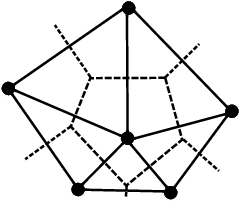These html pages are based on the
PhD thesis "Cluster-Based Parallelization of Simulations on Dynamically Adaptive Grids and Dynamic Resource Management" by Martin Schreiber.
There is also
more information and a PDF version available.
2.1 Grid generation
To store our simulation data at spatially related positions, we require a grid-generation strategy which
decomposes the domain into non-overlapping cells. Relevant simulation data can then be stored on
each grid cell and at hyperfaces separating the grid cells. The most commonly used cell-wise grid
generation for DG simulations on two-dimensional domains are Cartesian, Voronoi and triangular
ones:
-
(a)
- A Cartesian two-dimensional grid generation results in cells with edges parallel to the basis
vectors of a Cartesian coordinate system. Using such a structured grid, direct access of
the neighboring cells can lead to more efficient access of data in adjacent cells. However,
due to refinement of the grid in particular areas, hanging nodes are created (see [BL98] for
AMRClaw) and have to be handled in a special manner which is typically based on explicit
knowledge of the developer (cf. [BHK07,MNN11]).
-
(b)
- Simulations executed on grids generated by Voronoi diagrams (e.g. [Wel09, Ju07], see
dashed lines in Fig. 2.1) provide an alternative meshing, but make computations with
higher-order methods challenging due to the manifolds (e.g. different number of corners) of
different shapes.
-
(c)
- Using triangular grids for simulations, this yields two major beneficial components: First, there is
a duality between triangular grids generated by Delaunay triangulation and Voronoi
diagrams [She02,DZM07] as shown in Fig. 2.1. Thus, using a triangular grid would also allow us to
use it as a grid created by a Voronoi diagram algorithm. Second, adaptive Cartesian grid
generation leads to hanging nodes. These nodes can be avoided by inserting additional edges.
However, this also requires interfaces provided by the simulation developer. Using adaptive
triangular grids based on bisection of the triangle, such hanging nodes can be directly avoided by
inserting additional edges.
Due to the hanging nodes created by Cartesian-aligned grids and the very common usage of triangular
grids for two-dimensional DG-FEM (cf. [HW08,AS98]), we decided to use a triangulation of our
simulation domain.

